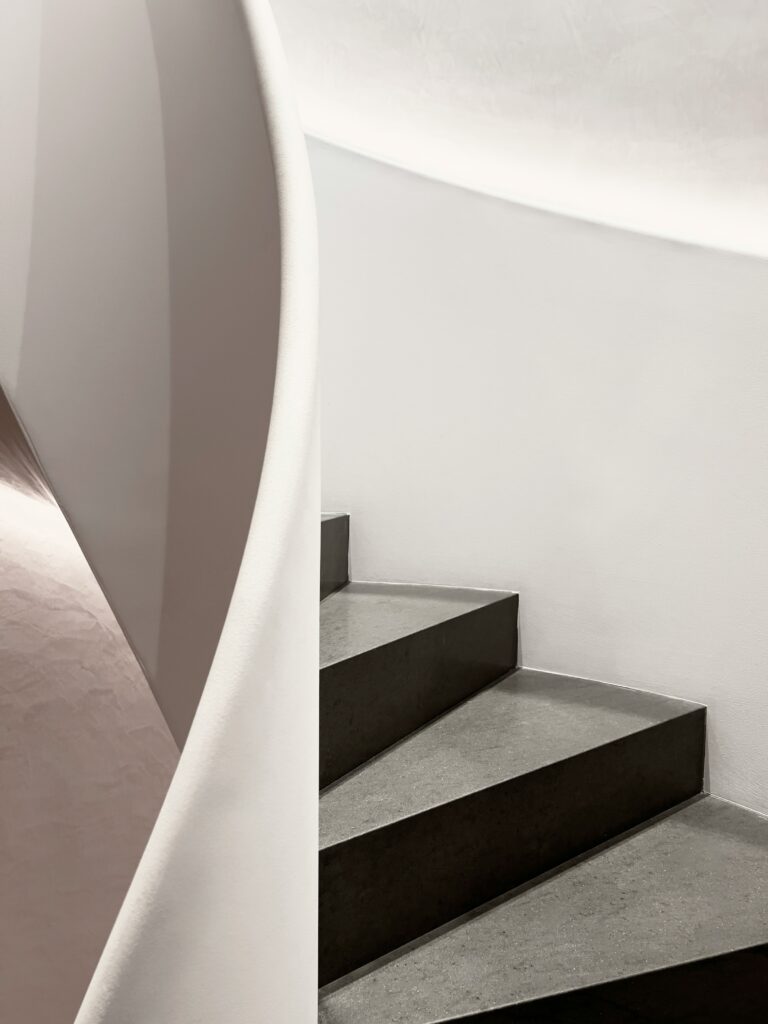Picture this: You’re finally sitting down at your desk, ready to write something new for your blog—something you’ve been meaning to do for what feels like forever!
You make yourself a cup of coffee, settle in, open your favorite writing app, and then… nothing.
Your mind goes blank.
Sounds familiar?
If you’re often feeling stuck on what to write about for your interior design blog, don’t worry.
In this post, we’ll explore some ways to spark inspiration, share tips for writing engaging home decor blog posts, and even show you how tools like ChatGPT can make the process easier.


Disclaimer: This blog post may contain affiliate links and we may earn a small commission when you click on the links or purchase paid products at no additional cost to you. We only recommend products and software we truly believe to be helpful for your business.
Do Interior Designers Need a Blog?
You might be thinking, “I already have so much on my plate—why should I bother with a blog?”
The truth is, not every designer needs a blog. But for some, it can be a game-changer.
Take virtual designers offering e-design services to clients around the world. If your business relies on website traffic to generate leads, a well-optimized blog post shared on Pinterest can work wonders for driving that traffic. Or maybe you run an online shop selling home decor accessories—again, if website traffic is critical for attracting customers, blogging can help make that happen.
A well-written blog does more than just boost your SEO.
It can help you:
- Show up in Google searches when potential clients are looking for answers or inspiration.
- Build trust by presenting yourself as a knowledgeable expert in your field.
- Grow your email list by including a simple way for readers to subscribe in your posts.
So, if you’ve got the time and resources—or if writing comes naturally to you—a blog can be an incredibly effective way to promote your interior design brand.



Creative Ways to Come Up with Blog Post Ideas for Interior Designers
Start with Competitor Research
Taking a look at what your competitors are blogging about can be a simple yet effective way to get inspired. Pay attention to what stands out in their posts: What topics grab your attention? What would make you consider hiring them if you were a potential client?
Use this research as a springboard for your own ideas—but don’t just copy what others are doing. Instead, think about how you can bring your unique perspective to the table. Tie the topic back to your own experiences or past projects, and let your personality shine through.
Sharing your thoughts and views not only adds originality but also helps potential clients connect with you on a deeper level.


Review Frequently Asked Questions from Existing and Potential Clients
Your frequently asked questions can be an endless source of blog ideas. People are always curious—whether it’s about your design process or specific design challenges.
By answering these questions, you’re giving your readers (and potential clients) exactly what they’re looking for, instead of guessing what might interest them.
And here’s the best part: FAQs aren’t just great for blogs—they’re also perfect for creating engaging social media content. Whether you’re making Instagram carousels, static posts, Reels, or even Instagram Lives, you can easily repurpose these FAQs into graphics or scripts for short videos to keep your followers engaged.



Expand on Your Popular Social Media Posts
Another easy idea is to take a popular social media post you’ve already shared and turn it into a blog post. You can expand on the main topic, add more details, and even include examples from your portfolio to make it more in-depth.
If a social media post has gotten a lot of engagement, it’s a good sign that the topic resonates with your audience. Just like with FAQs, this gives you a solid starting point, so you don’t have to guess what your audience might find interesting.
For example, if you posted a carousel or an informative Reel, you can use the caption as a foundation and then build it out into a full blog post.
And if you need a little extra help, you can always ask ChatGPT to help expand on your idea and give you pointers to work with.
A Roundup of Similar Posts
Another quick and effective idea is to create a roundup by collecting your previously published posts on a related topic and linking to them in your article.
For example, if you’ve worked on several kitchen renovation projects, you could pull together posts about these projects into a blog post that highlights your favorite kitchen features.
A roundup serves two purposes: it’s an easy way to create new content from what you already have, and it gives readers a simple way to explore more of your work by clicking through the linked posts and reading them later.


Before & After
A before-and-after blog post is a great way to highlight your favorite projects and turn them into a story—showing how they went from a client’s dream (or your vision) to reality.
Before-and-after content is some of the most engaging interior design material, whether it’s a social media post or a blog article. It not only showcases the full range of your design skills in a visually compelling way but also gives readers the behind-the-scenes story of the project.
Because this type of content is so powerful, it’s worth thinking ahead during the early stages of a client project. For instance, when doing the initial survey, take photos of the space from specific angles that will help you show the dramatic transformation once the project is finished.


Talk About Current Design Trends and Your Take on Them
This is an easy way to generate blog post ideas since new design trends are always popping up. Sharing your thoughts on them not only showcases your personality and preferences as an interior designer but also helps potential clients get a sense of your style when they’re considering whether to hire you.
And it doesn’t have to be limited to just the latest trends. You can also dive into specific design styles, share examples of how you’ve incorporated them into past projects, or compare different styles or features side by side, highlighting what you see as their strengths and weaknesses.
More Things to Consider When Writing Interior Design Blog Posts
Knowing what to write about is a great start, but it’s only the beginning. To make sure your blog posts attract potential clients—and aren’t just your thoughts on paper— keep these key points in mind as you write.
Make It Pinterest-Friendly
There’s no point in writing blog posts if no one’s reading them. While optimizing for Google search can bring in some traffic, Pinterest is a fantastic (and free!) tool for driving new visitors to your blog, even before Google takes notice.
As you write your posts, think about how they’ll look on Pinterest. Include high-resolution, Pinterest-friendly (vertical) images, and create Pinterest graphics in Canva. These graphics can be shared on Pinterest, helping you lead people back to your blog.


Focus on Blog Post Structure
Having a clear structure is key to keeping readers engaged from start to finish.
Think of your blog post structure like an Instagram caption: start with a catchy title to grab attention, just like you would with a hook in a caption. Then, provide valuable content throughout the post, and wrap it up with a call-to-action (CTA) to guide your readers on what to do next. Your CTA could encourage readers to book a free discovery call, subscribe to your newsletter, sign up for a free design class, or download a freebie.
Unlike an Instagram caption, though, you don’t have to place your CTA only at the end of your post. Feel free to include multiple CTAs throughout, and even embed a sign-up form within the post, especially if it’s a long one, since readers may not make it to the end.
Use High-Quality Visuals
Interior design is a visual industry, so a blog post with stunning images will be much more engaging than one that’s text-heavy with few or no visuals.
Photos from your own portfolio are ideal, but if you don’t have those, you can always use high-resolution stock images from sites like Pexels, Unsplash, or paid options like Shutterstock, if your budget allows.
Wherever you get your images, make sure they’re high-quality and relevant to your blog topic. And if you’re using stock photos, don’t forget to credit the source and include a disclaimer about where the images come from.


Consider Repurposing Potential
You probably can’t spend all your time creating fresh content, so repurposing is a great way to get more mileage out of what you already have. It’s also a key strategy for posting consistently across multiple platforms without needing a full-time marketing person on your team.
When planning and writing your blog posts, think about how you can reuse them for social media content. It’s not just about creating Pinterest graphics—you can also turn them into short video scripts for TikTok or Reels, or slides for Instagram carousels.
How to Use ChatGPT for Writing Interior Design Blog Posts
ChatGPT can be a great tool for content creation, but it’s still just that—a tool. We’re not quite at the point where it can replace a skilled content writer just yet.
That’s great for content writers, but what if you don’t have the budget to hire one? With a little help from ChatGPT, you can still create a solid blog post on your own.
Instead of having ChatGPT write the entire post for you, use it to assist with different steps of the writing process while you oversee and edit the final result.
Here’s how you can use ChatGPT to write a post for your interior design blog:
- Start by asking ChatGPT to come up with a structure for a blog post on your chosen topic.
- Review the points it suggests, pick the ones you like, and ask ChatGPT to expand on them. You can do this step by step, adding more detail and value through additional questions or prompts.
- Once you have your content, ask ChatGPT to help edit or rewrite the text to optimize it for search. You can give it a list of keywords or ask it to generate relevant ones for your blog post. In our experience, it’s better to treat SEO as a separate step rather than asking ChatGPT to create an SEO-friendly post from the start.
You’ll still need to supervise each step and make edits along the way, but ChatGPT can handle most of the heavy lifting, allowing you to create a high-quality blog post in much less time, even if you don’t have the budget for a professional writer.











